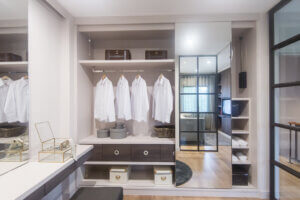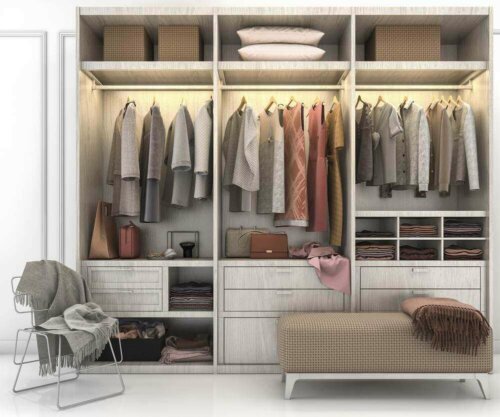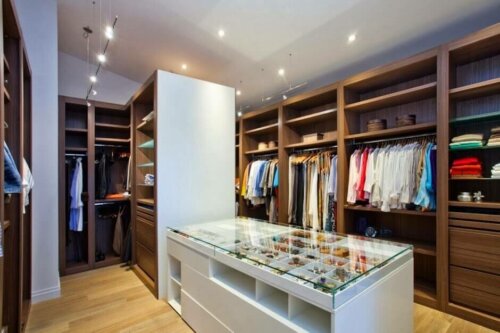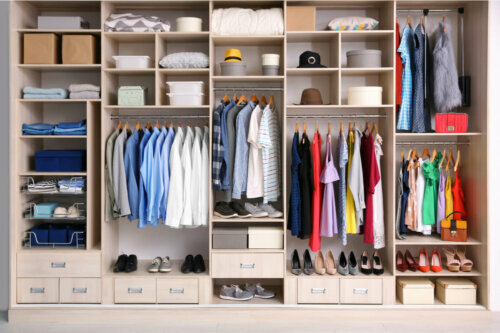Organization Ideas for a Functional Closet

To have a functional closet, you don’t need to know all of Marie Kondo’s ideas back to front. With a little bit of common sense and by following these guidelines, you’ll achieve it in no time.
It doesn’t matter if your dressing room is integrated into the bedroom or a separate room. The important thing is the functionality it has so you can get the most out of it.
The first steps to organizing a closet

The distribution of a functional closet
If you have a large room, you can install modular compartments on the bottom and both sides of the wall. If your room is smaller, we recommend doing without these modular compartments.
When the closet is open to another room, we recommend arranging it in an L shape, which will allow you to take advantage of the corner space.
Also, a functional closet can be made to measure and, although it’s a little more expensive, it’ll allow better use of space as it’ll adapt better to the shape of the room, regardless of whether or not it has a regular layout.
The expectation

The great advantage of closets is that you can organize them according to your needs. Therefore, it’s important to know what’s going to be stored to choose the right accessory or module for each piece or garment.
In addition to hanging rods (if they’re located in high areas, hydraulic ones that fold down when you pull a lever are ideal), there are pull-out trouser racks that take up little space and keep your pants from wrinkling.
Also, you should consider placing pull-out tie racks on the inside of the door, drawers with or without separators of different sizes, trays, and shoe racks. Also, boxes, baskets, and hangers are useful.
The space for a functional closet
The minimum proportions for a space dedicated to a closet are 4 x 5 feet. But if you’re also going to use it as a dressing room, then 21 1/2 square feet must be added. Keep these measurements in mind!
If the bedroom measures a maximum of 215 square feet, a separate closet can be added. Furthermore, if the room has an elongated layout, you can place it in a corner, separating it from the bedroom with a dividing wall.
If the bedroom is smaller, an open closet can be integrated. This is a great option since you won’t have to sacrifice any space from the other rooms or hallway.
If the room is square, we recommend placing the bed in the center and placing a drywall partition, acting as a headboard to define the closet area.
A functional closet – organize everything
Divide and conquer

More than space, functionality is determined by optimal distribution. This will be a factor in achieving your desired result.
In general, there’ll be a top part for suitcases or clothes from the previous season. A middle part, with high rods, for long dresses, and medium rods for skirts, short dresses, pants, jackets, and shirts.
Finally, in the lower area, there’ll be drawers that’ll help organize your T-shirts, underwear, and of course, your shoes.
Measurements to keep in mind
While organizing the interior of your closet, you must keep in mind some basic measurements. For example, to hang your clothes, you’ll need at least 24 inches of depth. For long coats and dresses, leave a gap between 60 and 70 inches high or between 25 and 44 inches for shorter pieces.
And, for storing underwear or smaller items, 6 inch deep drawers are sufficient. In the case of sweaters, the appropriate depth is 10 inches. These measurements will help you fold your clothes perfectly.
A 12-inch depth is enough for the upper shelves but if you keep blankets or comforters here, they can be as large as 18 inches. And very important – if you’re going to keep clothes in boxes, you must have a space of between 10 and 12 inches for them.
More than a wardrobe
Your closet offers the advantage of having all your clothes organized by categories and, therefore, it’s easier to find anything you need at any time.
If you leave off the doors and have the shelves and racks on show, the content of each cubby will be more visible. Therefore, you’ll create a more informal and casual effect and you’ll make the most out of the space.
Also, this is a more budget-friendly solution. The drawback is that the interior’s not protected from dust and clutter that may be exposed.
After reading these ideas, we’re sure you’ll take a look at your closet and get to work. Do you have a notepad and pen ready to take measurements and innovate your closet?








